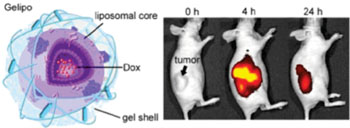ATP-Triggered Nanoparticles Effectively Kill Breast Cancer Cells in Mouse Model
By LabMedica International staff writers
Posted on 25 Mar 2014
A recent paper describes novel nanoparticles that transport toxic anticancer drugs specifically to tumor cells where they are engulfed and induced to release their cargo by the high intracellular concentration of adenosine-5'-triphosphate (ATP).Posted on 25 Mar 2014
The nanoparticles, which were composed of a liposomal core enclosed in a cross-linked hyaluronic acid (HA)-based gel shell (designated Gelipo), were devised by a team of investigators at North Carolina State University (Raleigh, USA) and the University of North Carolina (Chapel Hill, USA). The cores of the nanoparticles were loaded with an ATP-binding aptamer-incorporated DNA motif that was able to selectively release incorporated molecules of the cancer drug doxorubicin (Dox) via a conformational switch when in an ATP-rich environment. Aptamers are nucleic acid species that have been engineered through repeated rounds of in vitro selection to bind to various molecular targets such as small molecules, proteins, and nucleic acids.

Image: The structure of the ATP-triggered nanoparticle (left) and how the nanoparticles shrink a tumor (right) (Photo courtesy of North Carolina State University).
The nanoparticles were tested on a mouse cancer model. Following injection of the nanoparticles into mice carrying the MDA-MB-231 xenograft tumor, the HA shells were degraded by hyaluronidase (HAase) enzyme that was concentrated in the tumor environment. This resulted in the rapid internalization of the liposomes, which, in turn, caused release of the aptamer-DNA-Dox molecules into the tumor cells. The high concentration of ATP inside the tumor cells then caused the aptamer-DNA molecules to unfold and release the Dox, which killed the cells.
Results reported in the March 11, 2014, online edition of the journal Nature Communications showed that the new type of nanoparticles were 3.6 times more effective against MDA-MB-231 human breast cancer cells than previously tested nanoparticles that did not incorporate an ATP-triggered component.
"This is a proof of concept, but we have demonstrated there is now a new tool for introducing anti-cancer drugs directly into cancer cells—and that should make drug treatments significantly more effective," said senior author Dr. Zhen Gu, assistant professor in the joint biomedical engineering program at North Carolina State University and the University of North Carolina. "We also believe that we will be able to make the technique even more targeted by manipulating ATP levels in specific areas."
Related Links:
North Carolina State University
University of North Carolina














